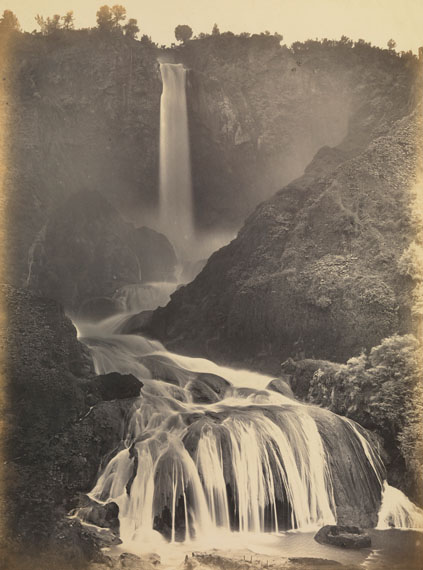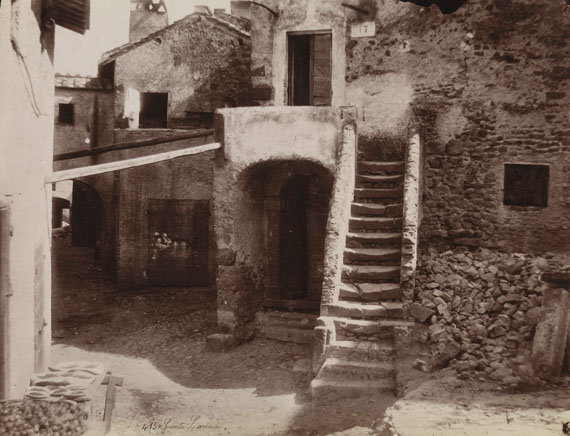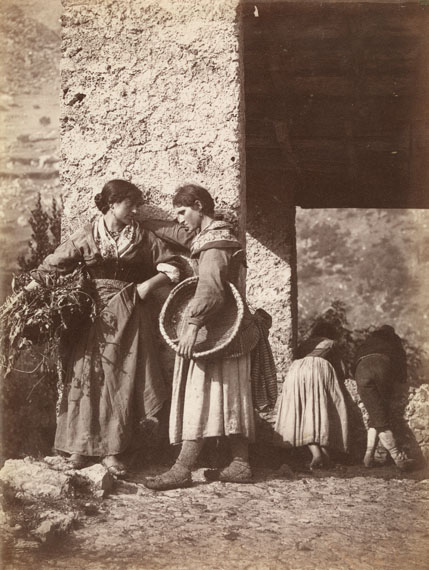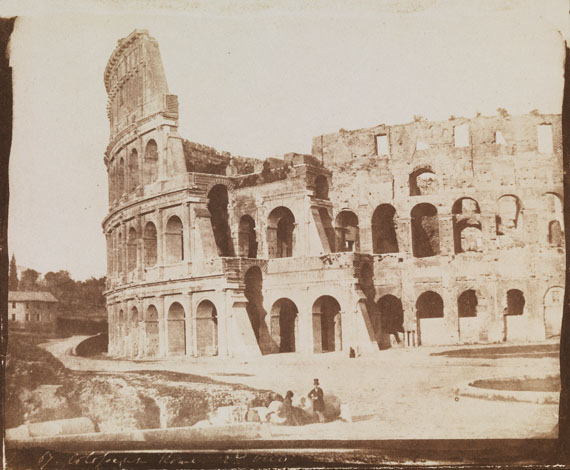
The Cascata delle Marmore near Terni, c. 1858
Albumen print, 42.2 x 31.3 cm
PATHOS UND IDYLLE
Italien in Fotografie und Malerei. Sammlung Dietmar Siegert
James Anderson » Enrico Béguin » Filippo Belli » Giacomo Caneva » Gustavo Eugenio Chauffourier » Calvert Richard Jones » Stefano Lecchi » Robert MacPherson » Wilhelm (Guglielmo) (von) Plüschow » Luigi Sacchi » Carlo Baldassare Simelli » & others
Exhibition: 21 May – 21 Sep 2015
Wed 20 May 19:00
Neue Pinakothek
Barer Str. 29
80799 München
089-23805195
info@pinakothek.de
www.pinakothek.de/neue-pinakothek
Thu-Mon 10-17, Wed 10-20

Civita Lavinia (Lanuvio)´, c. 1870
Albumen print, 19.8 x 25.7 cm
"HEROIC AND IDYLLIC"
Italy in photography and painting
The Dietmar Siegert Collection
Exhibition: 21 May – 21 September 2015
Opening: 20 May 7p.m.
The Neue Pinakothek has an outstanding collection of paintings evoking Italy’s legendary status as a focus of romantic yearning. Many of the paintings were acquired for the collection by its founder, King Ludwig I. Since last year, the Neue Pinakothek has also held an important collection of early photographs of Italian scenes: some 9700 images in all, dating from the period between 1846 and 1900, which were purchased from Dietmar Siegert by the Pinakotheks-Verein, with the support from the Ernst von Siemens Kunststiftung and the Sparkassen-Finanzgruppe, and presented to the museum on permanent loan. Now the exhibition "Heroic and Idyllic" offers an insight into the wealth of this newly acquired collection, with a display of around 100 selected images by the most famous photographers.
Photography and painting have had a lasting impact on the perception of Italy since the 19th century. Painters travelled to Italy to make sketches and paintings of its southern landscapes and folk traditions. Photographers followed their example, but they quickly opened up new areas of interest, such as photographs of historic monuments and contemporary events. Foreign travellers explored the famous landscapes, art treasures and historic sites in ever-growing numbers, and what had once been the Grand Tour of the privileged classes developed into modern tourism. Travellers provided both patrons and a viewing public for painters and photographers. The introductory part of the exhibition explains, by way of select examples, the characteristics and compositional techniques of early photography in
Italy. The early days in Rome are documented by some of the first photographs ever taken there, including some by Calvert Richard Jones. Key types of photographic image are then explored, such as nature photography, studies of clouds, photographs of sculpture and genre scenes. Compositional techniques such as tonal gradation, perspective and reflected light are explained and illustrated by outstanding examples.
The tour then leads on through five galleries of the Neue Pinakothek – from the Nazarenes to the so-called "Deutsch-Römer" – where selected photographs are displayed alongside paintings from the collection. Seen in this context, similarities and differences emerge. In the area of landscape painting, the "heroic" landscapes of Joseph Anton Koch and Johann Christian Reinhart, in which the Italian countryside is interpreted through the lens of the "sublime", are juxtaposed with large-format photographs by James Anderson and James MacPherson, whose images of waterfalls, rocks and ancient ruins capture a similar sense of lofty nobility.
In the gallery devoted to the "Deutsch-Römer", where Arnold Böcklin’s paintings conjure up the Arcadian idyll, visitors can see the sensitive nature studies of Giacomo Caneva and Carlo Baldassare Simelli and the sentimental evocation of ancient Italy in the photographs of Wilhelm von Gloeden and Wilhelm Plüschow.
In the area of genre scenes, the paintings of Friedrich Overbeck and Wilhelm von Schadow are paired up with early photographs by Giacomo Caneva and Enrico Béguin, whose female models exude the same aura of innocence and naturalness as the female figures of the Nazarenes. In the gallery devoted to German history paintings, on the other hand, the juxtaposition produces quite a different result. While the large canvases by Wilhelm von Kaulbach and Carl Theodor von Piloty portray events from ancient Roman history as scenes of high drama, the photographs, by contrast, capture moments of authenticity. Stefano Lecchi and Luigi Sacchi depict the war theatres of the Risorgimento, documenting the most momentous events in the history of Italy during this period, in subtle and moving images.
A visit to the Neue Pinakothek over the next few months, therefore, not only offers an insight into the history of the perception of Italy in photography and painting, but also into the relationship between two sister arts, one of which, painting, has always enjoyed recognition, while the other, photography, was only accorded full validation as an artistic medium in the 20th century.�

Genre scene in the Alban Hills, c. 1875
Albumen print, 25.3 x 18.5 cm
"PATHOS UND IDYLLE"
Italien in Fotografie und Malerei
Sammlung Dietmar Siegert
Ausstellung: 21. Mai bis 21. September 2015
Eröffnung: 20. Mai, 19 Uhr
Die Neue Pinakothek besitzt eine herausragende Sammlung an Gemälden, die den Mythos Italien als romantisches Sehnsuchtsmotiv inszenieren. Viele von ihnen kamen durch den Gründer des Museums, König Ludwig I., in die Sammlung. Seit dem vergangenen Jahr verfügt die Neue Pinakothek nun auch über eine bedeutende Sammlung an frühen Fotografien aus Italien: die rund 9700 Aufnahmen aus der Zeit von 1846 bis 1900, die der Pinakotheks-Verein in Verbindung mit der Ernst von Siemens Kunststiftung und der Sparkassen-Finanzgruppe von Dietmar Siegert erworben und dem Museum als Dauerleihgabe übergeben hat. Die Ausstellung "Pathos und Idylle" bietet nun einen Einblick in den Reichtum dieser jüngst erworbenen Sammlung und zeigt eine Auswahl von rund 100 Aufnahmen der namhaftesten Fotografen.
Fotografie und Malerei haben die Wahrnehmung Italiens seit dem 19. Jahrhundert nachhaltig geprägt. Bildende Künstler reisten dorthin, um in Studien und Gemälden die südliche Natur und das Volksleben darzustellen. Fotografen folgten ihnen darin, erschlossen aber rasch weitere Aufgabenfelder wie die Denkmäler- und Ereignisfotografie. Eine stetig wachsende Zahl von Reisenden erkundete die berühmten Landschaften, Kunstschätze und historischen Stätten. Aus der exklusiven Grand Tour entwickelte sich der moderne Tourismus. Die Reisenden waren Publikum und Kunden für Maler und Fotografen.
In einführenden Kapiteln werden exemplarisch Besonderheiten und Gestaltungsmittel der frühen Fotografie in Italien vorgestellt. Die Anfänge in Rom sind in der Ausstellung mit einigen der frühesten dort entstandenen Aufnahmen, unter anderem von Calvert Richard Jones, dokumentiert. Es folgen Schwerpunkte des fotografischen Bildes wie Natur- und Wolkenstudien, die Skulpturenfotografie oder die Genredarstellung. Außerdem werden Gestaltungsmittel wie Tonwertabstufungen, Perspektive und Lichtreflexe an herausragenden Beispielen vorgestellt.
Im weiteren Rundgang werden in fünf Sälen – von den Nazarenern bis zu den Deutsch-Römern – ausgewählte Fotografien unmittelbar zu den Gemälden der Sammlung in Beziehung gesetzt. Dabei treten Gemeinsamkeiten, aber auch Unterschiede zutage. Im Bereich der Landschaftsmalerei werden den heroischen Landschaften von Joseph Anton Koch und Johann Christian Reinhart, die die Natur Italiens in der Tradition des Erhabenen inszenieren, die großformatigen Aufnahmen von James Anderson und James MacPherson gegenübergestellt, die Wasserfälle, Felsen und antiken Ruinen auf vergleichbar pathetische Weise ins Bild setzen.
Im Saal der Deutsch-Römer, wo in den Gemälden Arnold Böcklins die arkadische Idylle beschworen wird, begegnet der Besucher den einfühlsamen Naturstudien von Giacomo Caneva und Carlo Baldassare Simelli sowie der sentimentalen Vergegenwärtigung des antiken Italiens in den Fotografien von Wilhelm von Gloeden und Wilhelm Plüschow.
Bei den Genredarstellungen werden den Gemälden von Friedrich Overbeck und Wilhelm von Schadow frühe Fotografien von Giacomo Caneva und Enrico Béguin hinzugefügt, deren weibliche Modelle dieselbe Aura von Unschuld und Natürlichkeit umgibt wie die Frauengestalten der Nazarener. Anders dagegen die Gegenüberstellung im Saal der gründerzeitlichen Historienmalerei: Während die großen Leinwände Wilhelm von Kaulbachs und Carl Theodor von Pilotys weltgeschichtliche Ereignisse als großes Theater inszenieren, setzt die Fotografie das Moment des Authentischen dagegen: Stefano Lecchi und Luigi Sacchi zeigen die Kriegschauplätze des Risorgimento, subtile und bewegende Dokumente des folgenreichsten Ereignisses in der italienischen Geschichte dieser Epoche.
Der Gang durch die Neue Pinakothek bietet damit in den kommenden Monaten nicht nur einen Einblick in die Geschichte der Wahrnehmung Italiens in Fotografie und Malerei, sondern auch einen Einblick in das Verhältnis der beiden Schwesterkünste, von denen die eine, die Malerei, einen traditionellen Geltungsanspruch besitzt, während die andere, die Fotografie, erst im 20. Jahrhundert zur vollgültigen Anerkennung als bildkünstlerisches Medium gelangt ist.
�

The Colosseum, Rome, 1846
Calotype, 18.9 x 22.7 cm